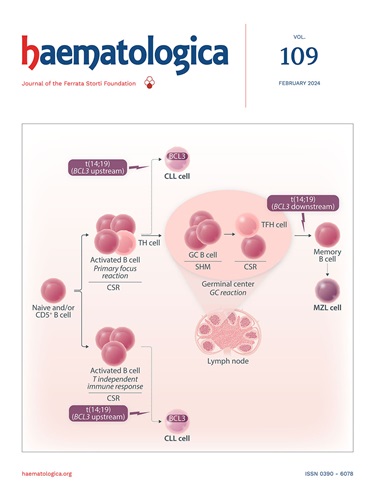CHIP:描绘克隆造血十年的发现。
IF 7.9
1区 医学
Q1 HEMATOLOGY
引用次数: 0
摘要
克隆造血(CH)涉及与髓系恶性肿瘤相关的年龄获得性突变的造血干细胞的扩增。下一代测序和单细胞测序的进步,以及计算建模,扩大了我们检测常见和罕见CH驱动因素的能力,包括单核苷酸变异和马赛克染色体改变,灵敏度越来越高。虽然测序方法在准确性、成本和检测低频变异的能力方面存在差异,但它们加深了我们对CH生物学的理解。越来越多的证据已经确定了体细胞驱动因素,如DNMT3A、TET2和ASXL1的变异,以及改变CH风险的种系遗传变异,强调了遗传和获得性因素之间复杂的相互作用。这些集体发现正在指导靶向治疗和干预措施的发展,特别是对于有进展为髓系肿瘤或心血管疾病风险的个体。此外,CH正在成为治疗实体瘤的临床相关因素,它可能影响肿瘤微环境、治疗反应和治疗相关并发症的风险。风险分层模型有助于早期识别和监测高风险个体,从而实现个性化治疗决策。卫生保健管理的范围继续扩大,从监测到干预,目前正在进行试验,在高危人群中检验预防策略。新兴的试验框架强调风险分层、年龄适宜性、包容性招募、分散试验模式以及传统临床和新型终点的使用。总之,这些进展反映了从被动观察到主动干预的转变,为卫生保健的早期发现、精确治疗和预防指明了方向。本文章由计算机程序翻译,如有差异,请以英文原文为准。
CHIP ahoy: charting a decade of discovery in clonal hematopoiesis.
Clonal hematopoiesis (CH) involves the expansion of hematopoietic stem cells with ageacquired mutations linked to myeloid malignancy. Advances in next-generation and single-cell sequencing, along with computational modeling, have expanded our ability to detect both common and rare CH drivers, including single-nucleotide variants and mosaic chromosomal alterations, with increasing sensitivity. While sequencing methods differ in accuracy, cost, and ability to detect low-frequency variants, they have deepened our understanding of CH biology. A growing body of evidence has identified both somatic drivers, such as variants in DNMT3A, TET2, and ASXL1, and germline genetic variants that modify CH risk, highlighting the complex interplay between inherited and acquired factors. These collective discoveries are guiding the development of targeted therapies and interventions, particularly for individuals at risk of progression to myeloid neoplasms or cardiovascular disease. Additionally, CH is emerging as a clinically relevant factor in the treatment of solid tumors, where it may influence the tumour microenvironment, treatment response and the risk of therapy-related complications. Risk stratification models are facilitating earlier identification and monitoring of high-risk individuals, enabling personalized treatment decisions. The scope of CH management continues to expand, from surveillance to intervention, with ongoing trials testing preventive strategies in high-risk populations. Emerging trial frameworks emphasize risk stratification, age-appropriateness, inclusive recruitment, decentralized trial models, and the use of traditional clinical and novel endpoints. Together, these advances reflect a shift from passive observation to proactive intervention, charting a course for early detection, precision treatment, and prevention in CH care.
求助全文
通过发布文献求助,成功后即可免费获取论文全文。
去求助
来源期刊

Haematologica
医学-血液学
CiteScore
14.10
自引率
2.00%
发文量
349
审稿时长
3-6 weeks
期刊介绍:
Haematologica is a journal that publishes articles within the broad field of hematology. It reports on novel findings in basic, clinical, and translational research.
Scope:
The scope of the journal includes reporting novel research results that:
Have a significant impact on understanding normal hematology or the development of hematological diseases.
Are likely to bring important changes to the diagnosis or treatment of hematological diseases.
 求助内容:
求助内容: 应助结果提醒方式:
应助结果提醒方式:


